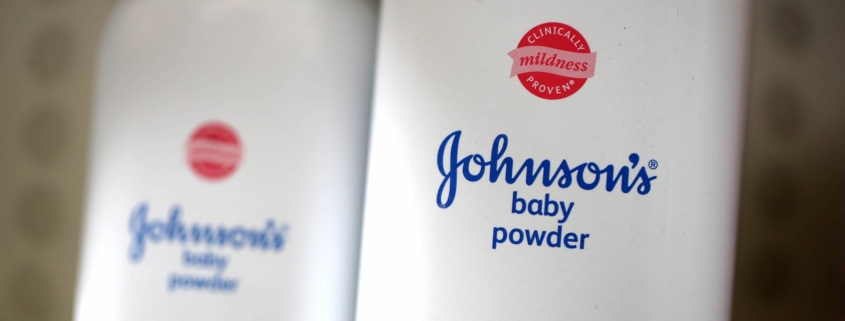Johnson & Johnson Preparing Talc Litigation
Johnson & Johnson, (J&J) is facing 25,000 talcum powder lawsuits filed by women who claim J&J’s Baby Powder contained asbestos that caused their cancers. The company announced recently it has set aside $3.9 billion in talc-related litigation costs and settlements.
The information was contained in a securities filing, released February 22, and it represents twice the amount the New Jersey-based company had planned to set aside for talc verdicts.
The healthcare giant has lost millions in talc-cancer jury trials after jurors are told how J&J knew from the early 1970’s that its raw talc sometimes tested positive for small amounts of asbestos but failed to alert the public. Talc is mined from the same areas as asbestos mines.
Just last year a lower court ruling was upheld awarding damages to 22 women, however the court lowered the award from $4.69 billion to $2.12 billion to compensate the women who claimed that Johnson’s baby powder led to their ovarian cancer.
Years ago, company advertisements encouraged women to use baby powder in their genital region to stay dry and feel fresh. At one time, J&J not only produced its baby powder with talc but the brand Shower-to-Shower as well.
“The company continues to believe that it has strong legal grounds for the appeal of this verdict, as well as other verdicts that it has appealed,” according to an official statement.
Attorney Mark Lanier, who brought one of the largest punitive damage awards in the U.S., tells Bloomberg. “Now J&J wants a get-out-of-jail-free card. A responsible company would pay their debts.”
Meanwhile, J&J is appealing the $2.12 billion Missouri verdict to the U.S. Supreme Court claiming the verdict was excessive.
[See Jefferson City, Missouri Ingham v. J&J, No. SC98674;
Appeal – Ingham v Johnson & Johnson et al, No. ED 207476]
While J&J says it has confidence in its talc products, the millions lost due to litigation and a decline in sales, caused the company to take its talc off the market last year in the U.S. and Canada blaming “misinformation” around the safety of its baby powder.
It didn’t help when, in October 2019, the Food and Drug Administration (FDA) recalled 33,000 bottles of baby powder due to trace amounts of asbestos found in a bottle.
Talc continues to be used in cosmetics. Consumers should check body powders to see if the manufacturer has switched from talc to cornstarch as the main ingredient.
As many as 20,000 cases of ovarian cancer are diagnosed every year, according to the Centers for Disease Control and Prevention (CDC). An estimated 14,000 cases prove fatal.
Mining Talc
Rio Tinto Minerals and its talc subsidiary, Luzenac America, mined the talc J&J used from a facility called Three Springs in Western Australia. Both companies have been named in lawsuits. U.S. actions also include defendant, San Jose-based Imerys Talc America, a talc mining company that acquired Luzenac in 2011.
The lawsuits have claimed the mining company knew for decades that of the potential for their talc to contain asbestos. In February 2019, J&J’s talc supplier, Imerys Talc America, Inc. and two affiliates filed a voluntary chapter 11 petition to reorganize in bankruptcy court.
Scientists have found small pieces of talc in tumors growing on the ovary. The talc is believed to enter through the vagina and make its way into the uterus through the fallopian tube to reach the ovary where it incites inflammation and cancer.
Mesothelioma
In October 2020, J&J announced it would pay about $100 million to settle one-thousand cases. Some involved cancer from mesothelioma, a malignancy that results from inhaling asbestos fibers. Tumors form in the lining of the heart, lungs, or abdomen. Asbestos is the only known cause of this aggressive cancer.
A 2019 lawsuit in New York state court resulted in a $325 million award to a woman who had developed pleural mesothelioma cancer. Her husband states she was a long-time user of Johnson’s baby powder.
The first talc-mesothelioma trial in New Jersey in 2018 resulted in a $25.9 million jury award to a couple.
The Verdicts Continue
In November 2020, a Brooklyn woman was awarded $120 million alleging her cancer resulted from exposure to asbestos from J&J’s baby powder. The judge lowered her original award of $325 million from the jury, which included $300 million in punitive damages.
Jurors reacted to evidence at trial that showed the company knew from 1971 to the early 2000s that J&J’s talc had, at times, tested positive for small amounts of asbestos.
Donna Olson testified she used J&J’s baby powder for more than 50 years.
The Normal Course of Business
In its securities filing, J&J refers to the cost of talc litigation as “the normal course of business.” It includes in that grouping billions to pay the ongoing cost of litigation including opioid, defective hip prosthesis, Xarelto, Elmiron, transvaginal and hernia polypropylene mesh.
So far, 41 states have joined an investigation into the company’s marketing of its talcum products.
In January 2020, New Mexico filed a consumer protection case alleging J&J deceptively marketed and sold its talcum powder by making misrepresentations about the safety of its products.
In June 2014, the Mississippi Attorney General filed a complaint against J&J alleging a violation of the state’s Consumer Protection Act by failing to disclose the alleged health risks of the talcum-based baby powder. Oral arguments were held in February 2021.
Litigation has been filed in state courts in Missouri, New Jersey, and California.
Stockholders are involved in litigation against the company as well filing actions against Johnson & Johnson and certain named officers alleging the company violated federal securities laws by failing to disclose what it knew about alleged asbestos contamination in talc-based body powder.
Sources:
10-K J7J
https://johnsonandjohnson.gcs-web.com/static-files/e2a329b4-aeb6-438d-a449-f0e282cf8ee0




Leave a Reply
Want to join the discussion?Feel free to contribute!